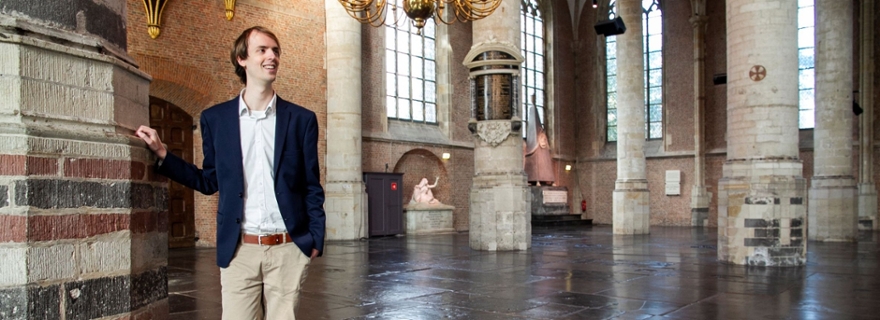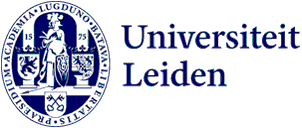
'The Pieterskerk has always defined Leiden's identity'
Ward Hoskens started ten years ago as an intern at one of Leiden's most iconic buildings: the Pieterskerk. Now he is doing his PhD on the question of how the function of this 'church that is no longer a church' changed over recent centuries.
When discussing heritage, the emphasis is often on architectural or art history. Hoskens wanted to take a different approach. Besides the building, the use and cultural-historical development had to be central, and not at one moment in history, but with a view over the longer term. 'I want to bring a different shade of meaning to the idea that in history you have to think mainly in breakpoints,' Hoskens explains. 'Heritage is actually constantly changing. I want to show this permanent development in my research.'
Nevertheless, Hoskens begins his research at a distinctive point in time: the Batavian Revolution of 1795. Under the guise of 'liberté, egalité, fraternité', the Batavians stripped the church of all noble symbols. Coats of arms disappeared from pillars and tombstones, the city council and dignitaries even lost their own chairs. 'That is a breakpoint,' Hoskens admits, 'but it's also the point at which people realise that perhaps a lot is being lost. They start asking themselves what should actually be preserved. That’s when things started moving, which even now often determine how we see the Pieterskerk. Besides, of course, the events of 1795 were not isolated either.
Preservation or use?
One of the things that started to move was the continuing debate about the building's significance. Hoskens: 'In fact, we still see two schools of thought: for some, the Pieterskerk is a monument that should be preserved as it is, while for others it is above all a place that should be in use. If you don't use the Pieterskerk, you can't preserve it; it's as simple as that. But if you allow everything, you can't guarantee its preservation either.'
Especially with the Pieterskerk, such disagreements can become heated because the monument is important for the history and identity of Leiden. 'Not to want to shortchange other historical buildings, but when people look for a relationship with history, they often look - and looked - at the Pieterskerk in Leiden,' says Hoskens. 'Precisely because it was the main church in Leiden, all kinds of stories of national and local identity have become attached to it. Take, for instance, the nickname 'Key City'. That comes from the keys of Saint Peter, the church's namesake. At the same time, you see that society is changing. The use of the church therefore also has to evolve, otherwise its usefulness and hence its function as a common frame of reference will disappear.
Chickens in the church
A notable period when the Pieterskerk changed with society was the 1970s, when the Reformed congregation rejected the church, and the discussion about what to do with the building flared up. 'In 1970, a number of students had been commissioned to organise an academic anniversary conference in the Pieterskerk,' Hoskens says. 'They filled the whole church with banners and huge art installations. The railing around the monument to Boerhaave was even used to create a chicken coop.'
It soon became clear that there was little support for this approach. 'Those chickens were such an absurd idea, and we can say with certainty that they will never return,' says Hoskens, who also works as curator of the Pieterskerk. 'At the same time, you see that at the foundation that is responsible for the management of the Pieterskerk, there is a move towards democratisation. What are the current issues in society and how can we respond to them?'
Het bleek al snel dat er voor deze aanpak weinig draagvlak was. ‘Die kippen waren zo’n absurd idee, daarvan kun je meteen zeggen dat die nooit meer zullen terugkomen’, zegt Hoskens, die ook werkt als conservator van de Pieterskerk. ‘Tegelijkertijd zie je dat bij de stichting die het beheer van de Pieterskerk overneemt al snel een democratiseringsgedachte ontstaat. Welke vragen leven er in de samenleving en hoe kunnen we dat faciliteren?’
Making the invisible visible
Hoskens' thesis also provides inspiration enough for answers to that question. 'For example, we are now in the process of giving more attention to what we call "invisible history". For instance, for a very long time remarkably little attention has been paid to the colonial and slavery past, women's history or social history. These are all intrinsically linked to the monument. If you can show those historical stories in a place that is such an important marker of Leiden's identity, it is of course very powerful. Anyway, in general, forgotten historical stories often have more to say about the development of cultural heritage than people expect.'
